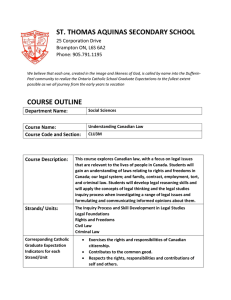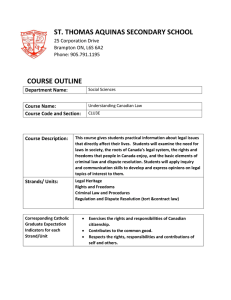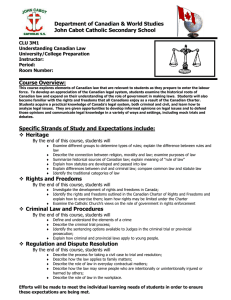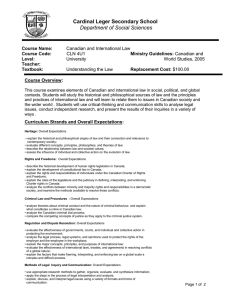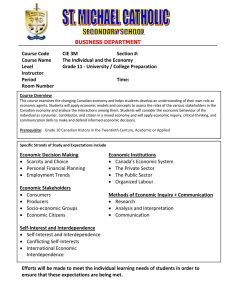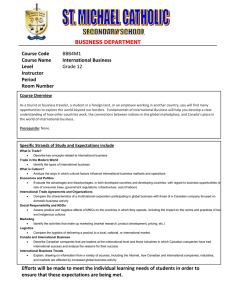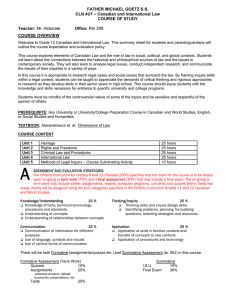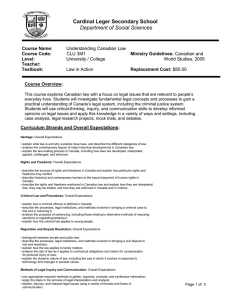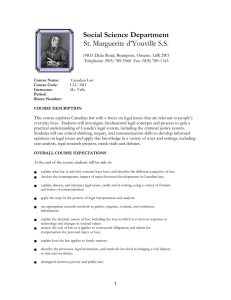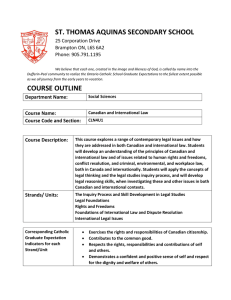Course Overview: CLN 4U1 Canadian and International Law
advertisement
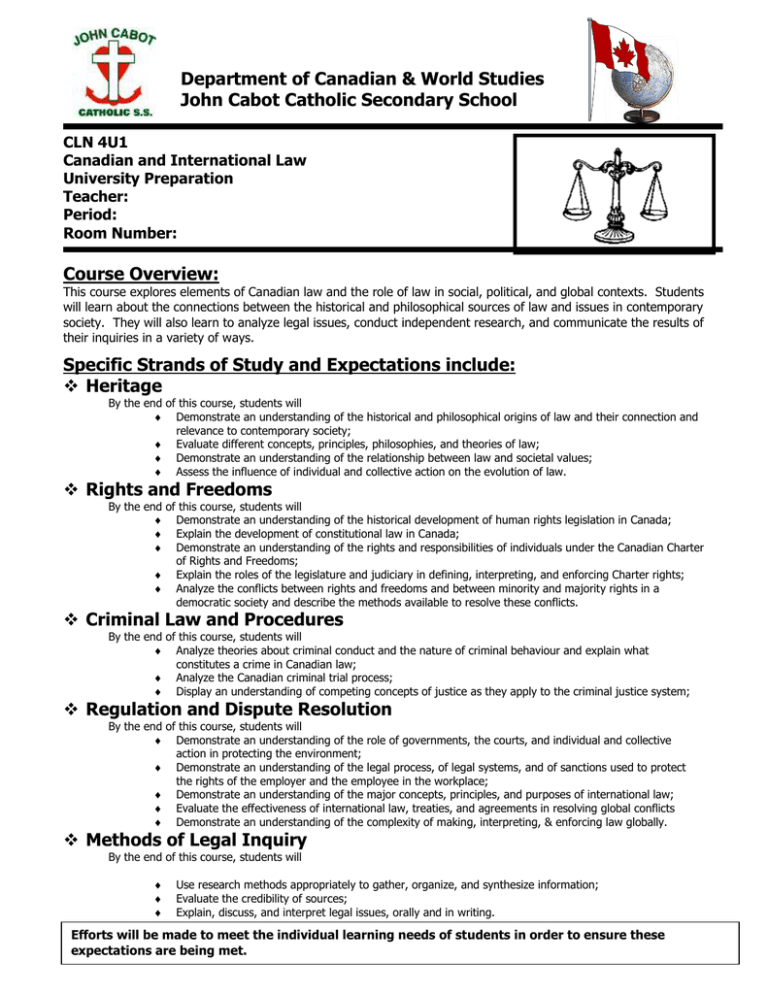
Department of Canadian & World Studies John Cabot Catholic Secondary School CLN 4U1 Canadian and International Law University Preparation Teacher: Period: Room Number: Course Overview: This course explores elements of Canadian law and the role of law in social, political, and global contexts. Students will learn about the connections between the historical and philosophical sources of law and issues in contemporary society. They will also learn to analyze legal issues, conduct independent research, and communicate the results of their inquiries in a variety of ways. Specific Strands of Study and Expectations include: Heritage By the end of this course, students will Demonstrate an understanding of the historical and philosophical origins of law and their connection and relevance to contemporary society; Evaluate different concepts, principles, philosophies, and theories of law; Demonstrate an understanding of the relationship between law and societal values; Assess the influence of individual and collective action on the evolution of law. Rights and Freedoms By the end of this course, students will Demonstrate an understanding of the historical development of human rights legislation in Canada; Explain the development of constitutional law in Canada; Demonstrate an understanding of the rights and responsibilities of individuals under the Canadian Charter of Rights and Freedoms; Explain the roles of the legislature and judiciary in defining, interpreting, and enforcing Charter rights; Analyze the conflicts between rights and freedoms and between minority and majority rights in a democratic society and describe the methods available to resolve these conflicts. Criminal Law and Procedures By the end of this course, students will Analyze theories about criminal conduct and the nature of criminal behaviour and explain what constitutes a crime in Canadian law; Analyze the Canadian criminal trial process; Display an understanding of competing concepts of justice as they apply to the criminal justice system; Regulation and Dispute Resolution By the end of this course, students will Demonstrate an understanding of the role of governments, the courts, and individual and collective action in protecting the environment; Demonstrate an understanding of the legal process, of legal systems, and of sanctions used to protect the rights of the employer and the employee in the workplace; Demonstrate an understanding of the major concepts, principles, and purposes of international law; Evaluate the effectiveness of international law, treaties, and agreements in resolving global conflicts Demonstrate an understanding of the complexity of making, interpreting, & enforcing law globally. Methods of Legal Inquiry By the end of this course, students will Use research methods appropriately to gather, organize, and synthesize information; Evaluate the credibility of sources; Explain, discuss, and interpret legal issues, orally and in writing. Efforts will be made to meet the individual learning needs of students in order to ensure these expectations are being met. Course Breakdown Evaluation Structure: Unit One: Heritage 20 hours Unit Two: Rights and Freedoms 20 hours Unit Three: Criminal Law and Procedures 35 hours Unit Four: Regulation & Dispute Resolution 35 hours Unit Five: Methods of Legal Inquiry Throughout the course Marks will be recorded according to the following competencies: Knowledge/Understanding 20% Thinking/Inquiry 25% Communication 25% Application 30% Furthermore, evaluation is divided as such: Term Work Final Exam 70% 30% Resources: The course will use a variety of resources including video, CD-ROM, the Internet and a variety of print sources. The textbook Understanding the Law – Second Edition will be distributed to students. The text and all other resources assigned to students are the responsibility of the student. Any damage or loss incurred will result in payment for replacement. The replacement cost is $80.00. Evaluation Policy Students will be assessed & evaluated according to the work produced & skills displayed. Methods of providing feedback will include assessing work in process & evaluating completed assignments, tests, co-operative learning activities, simulations and presentations. Peer & self-evaluations will also be utilized. Student marks will be determined by evaluating process & product according to 4 categories & 4 levels. Please see the chart below for specific skills and key words used to determine student competency in the different categories. Level Category Knowledge/Understanding Knowledge of facts & terms Understanding of concepts & relationships Thinking/Inquiry Critical thinking skills Creative thinking skills Inquiry Skills Communication Communication of ideas and information Use of symbols & visuals Oral & written communication Level 1: 50-59% Level 2: 60-69% Level 3: 70-79% Level 4: 80-100% -Limited display of knowledge, skills and ability to apply concepts -Some success in displaying knowledge, skills and application of concepts -Considerable display of knowledge skills and ability to apply concepts -Thorough understanding of concepts and ability to communicate, think creatively & apply concepts Application Applications in familiar contexts Transfer of concepts to new contexts Making logical conclusions and predictions Use of technology Making connections Feedback will also be provided regarding student learning skills. Skills like working independently, team work, organization, work habits and homework, and initiative are assessed independently of student achievement and will be conducted through the use of a rubric indicating specific criteria to be achieved to receive each of the following letter grades: E –Excellent Other Evaluation Issues G – Good S – Satisfactory N - Needs Improvement LATE ASSIGNMENTS. Assignments submitted after the Primary Due Date established by the teacher will be accepted with a penalty of 5% off for the first day late and 2% for subsequent days to a maximum of 10%. This four day Penalty Zone is the maximum time allowed for submissions. The fourth day after the assignment is due is considered the Closure Date upon which no further assignments will be accepted. If the teacher returns the marked assignments within the four day penalty zone, the date of return is considered the closure date. Repeated lateness in submissions indicates poor organization skills and will result in parental contact and will be reflected in the learning skills section of the report card. INCOMPLETE ASSSIGNMENTS Assignments will be graded according to the extent with which they meet the criteria established in the rubric or evaluation structure. MISSED TESTS Tests missed with a legitimate reason will be written within a few days of the student returning from the absence. Student eligibility to write the test and the date of writing will be at the discretion of the teacher in consultation with the department head. CULMINATING ACTIVITIES These activities will be due toward the end of the course. They are valued between 5 and 15 per cent of the final mark and will reflect course material and competencies not otherwise reflected on the final exam. Plagiarism in any form reflects academic dishonesty and will result in a mark of zero for the assignment in question
